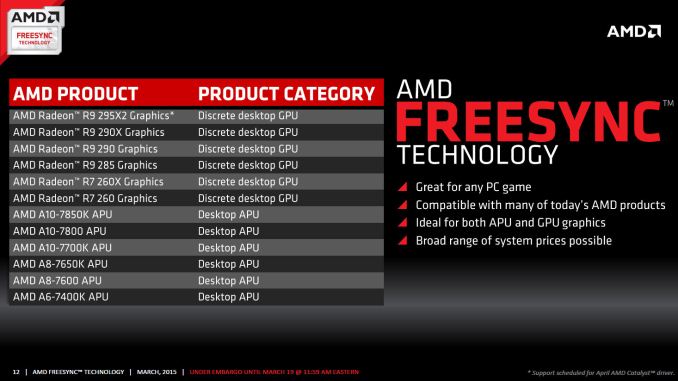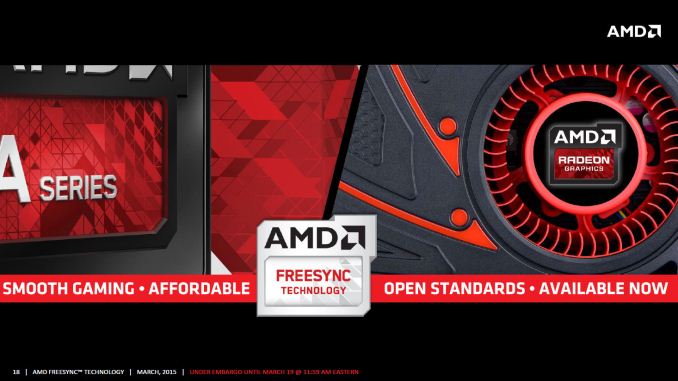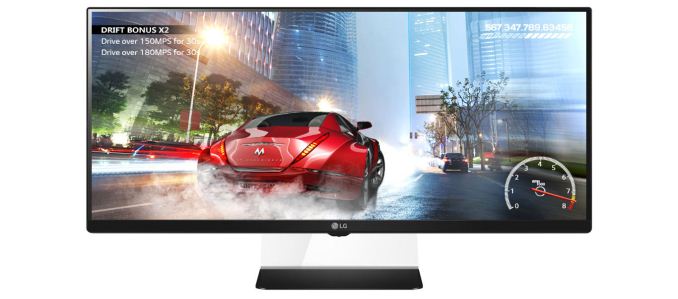The AMD FreeSync Review
by Jarred Walton on March 19, 2015 12:00 PM ESTClosing Thoughts
It took a while to get here, but if the proof is in the eating of the pudding, FreeSync tastes just as good as G-SYNC when it comes to adaptive refresh rates. Within the supported refresh rate range, I found nothing to complain about. Perhaps more importantly, while you’re not getting a “free” monitor upgrade, the current prices of the FreeSync displays are very close to what you’d pay for an equivalent display that doesn’t have adaptive sync. That’s great news, and with the major scaler manufacturers on board with adaptive sync the price disparity should only shrink over time.
The short summary is that FreeSync works just as you’d expect, and at least in our limited testing so far there have been no problems. Which isn’t to say that FreeSync will work with every possible AMD setup right now. As noted last month, the initial FreeSync driver that AMD provided (Catalyst 15.3 Beta 1) only allows FreeSync to work with single GPU configurations. Another driver should be coming next month that will support FreeSync with CrossFire setups.
Besides needing a driver and FreeSync display, you also need a GPU that uses AMD’s GCN 1.1 or later architecture. The list at present consists of the R7 260/260X, R9 285, R9 290/290X/295X2 discrete GPUs, as well as the Kaveri APUs – A6-7400K, A8-7600/7650K, and A10-7700K/7800/7850K. First generation GCN 1.0 cards (HD 7950/7970 or R9 280/280X and similar) are not supported.
All is not sunshine and roses, however. Part of the problem with reviewing something like FreeSync is that we're inherently tied to the hardware we receive, in this case the LG 34UM67 display. Armed with an R9 290X and running at the native resolution, the vast majority of games will run at 48FPS or above even at maximum detail settings, though of course there are exceptions. This means they look and feel smooth. But what happens with more demanding games or with lower performance GPUs? If you're running without VSYNC, you'd get tearing below 48FPS, while with VSYNC you'd get stuttering.
Neither is ideal, but how much this impacts your experience will depend on the game and individual. G-SYNC handles dropping below the minimum FPS more gracefully than FreeSync, though if you're routinely falling below the minimum FreeSync refresh rate we'd argue that you should lower the settings. Mostly what you get with FreeSync/G-SYNC is the ability to have smooth gaming at 40-60 FPS and not just 60+ FPS.
Other sites are reporting ghosting on FreeSync displays, but that's not inherent to the technology. Rather, it's a display specific problem (just as the amount of ghosting on normal LCDs is display specific). Using higher quality panels and hardware designed to reduce/eliminate ghosting is the solution. The FreeSync displays so far appear to not have the same level of anti-ghosting as the currently available G-SYNC panels, which is unfortunate if true. (Note that we've only looked at the LG 34UM67, so we can't report on all the FreeSync displays.) Again, ghosting shouldn't be a FreeSync issue so much as a panel/scaler/firmware problem, so we'll hold off on further commentary until we get to the monitor reviews.
One final topic to address is something that has become more noticeable to me over the past few months. While G-SYNC/FreeSync can make a big difference when frame rates are in the 40~75 FPS range, as you go beyond that point the benefits are a lot less clear. Take the 144Hz ASUS ROG Swift as an example. Even with G-SYNC disabled, the 144Hz refresh rate makes tearing rather difficult to spot, at least in my experience. Considering pixel response times for LCDs are not instantaneous and combine that with the way our human eyes and brain process the world and for all the hype I still think having high refresh rates with VSYNC disabled gets you 98% of the way to the goal of smooth gaming with no noticeable visual artifacts (at least for those of us without superhuman eyesight).
Overall, I’m impressed with what AMD has delivered so far with FreeSync. AMD gamers in particular will want to keep an eye on the new and upcoming FreeSync displays. They may not be the “must have” upgrade right now, but if you’re in the market and the price premium is less than $50, why not get FreeSync? On the other hand, for NVIDIA users things just got more complicated. Assuming you haven’t already jumped on the G-SYNC train, there’s now this question of whether or not NVIDIA will support non-G-SYNC displays that implement DisplayPort’s Adaptive Sync technology. I have little doubt that NVIDIA can support FreeSync panels, but whether they will support them is far less certain. Given the current price premium on G-SYNC displays, it’s probably a good time to sit back and wait a few months to see how things develop.
There is one G-SYNC display that I’m still waiting to see, however: Acer’s 27” 1440p144 IPS (AHVA) XB270HU. It was teased at CES and it could very well be the holy grail of displays. It’s scheduled to launch next month, and official pricing is $799 (with some pre-orders now online at higher prices). We might see a FreeSync variant of the XB270HU as well in the coming months, if not from Acer than likely from some other manufacturer. For those that work with images and movies as well as playing games, IPS/AHVA displays with G-SYNC or FreeSync support are definitely needed.
Wrapping up, if you haven’t upgraded your display in a while, now is a good time to take stock of the various options. IPS and other wide viewing angle displays have come down quite a bit in pricing, and there are overclockable 27” and 30” IPS displays that don’t cost much at all. Unfortunately, if you want a guaranteed high refresh rate, there’s a good chance you’re going to have to settle for TN. The new UltraWide LG displays with 75Hz IPS panels at least deliver a moderate improvement though, and they now come with FreeSync as an added bonus.
Considering a good display can last 5+ years, making a larger investment isn’t a bad idea, but by the same token rushing into a new display isn’t advisable either as you don't want to end up stuck with a "lemon" or a dead technology. Take some time, read the reviews, and then find the display that you will be happy to use for the next half decade. At least by then we should have a better idea of which display technologies will stick around.













350 Comments
View All Comments
medi03 - Thursday, March 19, 2015 - link
nVidia's roalty cost for GSync is infinity.They've stated they were not going to license it to anyone.
chizow - Thursday, March 19, 2015 - link
It's actually nil, they have never once said there is a royalty fee attached to G-Sync.Creig - Friday, March 20, 2015 - link
TechPowerup"NVIDIA Sacrifices VESA Adaptive Sync Tech to Rake in G-SYNC Royalties"
WCCF Tech
"AMD FreeSync, unlike Nvidia G-Sync is completely and utterly royalty free"
The Tech Report
"Like the rest of the standard—and unlike G-Sync—this "Adaptive-Sync" feature is royalty-free."
chizow - Friday, March 20, 2015 - link
@CreigAgain, please link confirmation from Nvidia that G-Sync carries a penny of royalty fees. BoM for the G-Sync module is not the same as a Royalty Fee, especially because as we have seen, that G-Sync module may very well be the secret sauce FreeSync is missing in providing an equivalent experience as G-Sync.
Indeed, a quote from someone who didn't just take AMD's word for it: http://www.pcper.com/reviews/Displays/AMD-FreeSync...
"I have it from people that I definitely trust that NVIDIA is not charging a licensing fee to monitor vendors that integrate G-Sync technology into monitors. What they do charge is a price for the G-Sync module, a piece of hardware that replaces the scalar that would normally be present in a modern PC display. "
JarredWalton - Friday, March 20, 2015 - link
Finish the quote:"It might be a matter of semantics to some, but a licensing fee is not being charged, as instead the vendor is paying a fee in the range of $40-60 for the module that handles the G-Sync logic."
Of course, royalties for using the G-SYNC brand is the real question -- not royalties for using the G-SYNC module. But even if NVIDIA doesn't charge "royalties" in the normal sense, they're charging a premium for a G-SYNC scaler compared to a regular scaler. Interestingly, if the G-SYNC module is only $40-$60, that means the LCD manufacturers are adding $100 over the cost of the module.
chizow - Friday, March 20, 2015 - link
Why is there a need to finish the quote? If you get a spoiler and turbo charger in your next car, are they charging you a royalty fee? It's not semantics to anyone who actually understands the simple notion: better tech = more hardware = higher price tag.AnnihilatorX - Sunday, March 22, 2015 - link
Nvidia is making profit over the Gsync module, how's that different from a royalty?chizow - Monday, March 23, 2015 - link
@AnnihilatorX, how is "making profit from" suddenly the key determining factor for being a royalty? Is AMD charging you a royalty every time you buy one of their graphics cards? Complete and utter rubbish. Honestly, as much as some want to say it is "semantics", it really isn't, it comes down to clear definitions that are specific in usage particularly in legal or contract contexts.A Royalty is a negotiated fee for using a brand, good, or service that is paid continuously per use or at predetermined intervals. That is completely different than charging a set price for Bill of Material for an actual component that is integrated into a product you can purchase at a premium. It is obvious to anyone that additional component adds value to the product and is reflected in the higher price. This is in no way, a royalty.
Alexvrb - Monday, March 23, 2015 - link
Jarred, Chizow is the most diehard Nvidia fanboy on Anandtech. There is nothing you could say to him to convince him that Freesync/Adaptive Sync is in any way better than G-Sync (pricing or otherwise). Just being unavailable on Nvidia hardware makes it completely useless to him. At least until Nvidia adopts it. Then it'll suddenly be a triumph of open standards, all thanks to VESA and Nvidia and possibly some other unimportant company.chizow - Monday, March 23, 2015 - link
And Alexvrb is one of the staunchest AMD supporters on Anandtech. There is quite a lot that could convince me FreeSync is better than G-Sync, that it actually does what it sets out to do without issues or compromise, but clearly that isn't covered in this Bubble Gum Review of the technology. Unlike the budget-focused crowd that AMD targets, Price is not going to be the driving factor for me especially if one solution is better than the other at achieving what it sets out to do, so yes, while Freesync is cheaper, to me it is obvious why, it's just not as good as G-Sync.But yes, I'm honestly ambivalent to whether or not Nvidia supports Adaptive Sync or not, as long as they continue to support G-Sync as their premium option than it's np. Supporting Adaptive Sync as their cheap/low-end solution would just be one less reason for anyone to buy an AMD graphics card, which would probably be an unintended consequence for AMD.